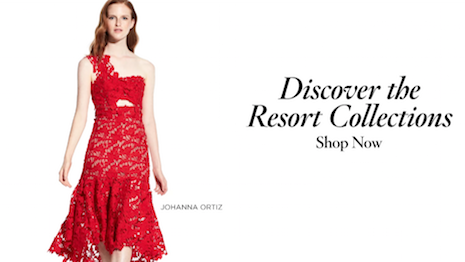By Anthony Nicalo
The primary focus of Google I/O 2016 centered on mobile consumer experiences and artificial intelligence.
The annual event provides in-depth sessions on building Web, mobile and enterprise applications with Google and open Web technologies. What became incredibly clear at this year’s event is that technology is fundamentally reshaping customer expectations by redefining luxury and convenience.
Performance used to be synonymous with BMW, convenience was a personal shopper at Bergdorf Goodman, and on-demand meant Jeeves bringing up a bottle from the cellar.
Now, performance means high-performing mobile sites, convenience translates into whatever form of shopping best suits the customer in that mobile moment, and on-demand delivery happens within the hour.
Make your brand to-go
With 70 percent of the United States population using smartphones, and 59 percent expecting companies to make mobile-friendly Web sites, brands need to focus on addressing three needs: simplicity, convenience and context.
Meaning, you need to reach consumers wherever they are at the mobile moment, make the shopping experience effortless, and generate relevant information based on their locations and behavior.
1. Keep it fast and simple. Companies such as Uber and Tesla are leading the on-demand economy by providing customers the power to request a driver or summon their own vehicles to pick them up.
Shoppers browse more on faster mobile Web sites. Prioritize performance, convenience and on-demand notions to meet the needs of your on-the-go mobile consumers looking for the simplest way to quickly get what they need.
2. Connect with your customer. Burberry takes convenience and immediacy to a whole new level by streaming its fashion shows for fans to watch anywhere worldwide and making the collections immediately available for purchase.
If you make purchases convenient and explore additional opportunities to connect through timely content and a direct call to action, it can result in huge sales.
The opportunity to stand out from the crowd here is tremendous, as only 23 percent of luxury brands in the U.S. offer in-store pickup of purchases made online.
Burberry also creates a heightened sense of luxury by connecting customers through Apple TV to Burberry customer service consultants to pre-order select pieces from the collection.
3. Provide relevant content, stay relevant. Customers care about more than just load times. They also value brands that act in a timely manner, know their interests, and provide the best deals based on their current locations.
Mobile devices are far more personal than laptops, so brands that take advantage of the wealth of data mobile provides — such as browsing behavior, search query and check-ins — will connect with consumers on a deeper level.
Sending the right information at the right moment is important, but sealing the deal also resides in an efficient checkout process.
This is why Cole Haan pioneered the swift checkout process with easy one-click payments through Apple Pay. And, as we learned at I/O, more convenient payment methods are coming to the Web in the next few months.
So, to deliver the convenience and simplicity shoppers expect during the upcoming holiday season, leading luxury brands need to deliver app-like payment options for mobile users.
WHILE NEW TECHNOLOGY is redefining traditional luxury brands, all of it still supports the industry’s core belief: cater to the customer by providing consistent, high-quality products and outstanding, high-touch service – even if that touch is virtual.
Mobile technology offers a plethora of competitive advantages by making these goals easier to achieve with contemporary modern, mobile customers.
If luxury brands embrace mobile as another tool to make the customer happy and increase sales, the opportunities are endless.
 Anthony Nicalo is vice president of platform at Mobify
Anthony Nicalo is vice president of platform at Mobify
Anthony Nicalo is vice president of platform at Mobify, Vancouver, British Columbia, Canada. Reach him at [email protected].
{"ct":"3unDah8CbkmRH+zN6JAYV6MJ3CuwEx7FIo4z8nPTqO6IQS0OikJbfLjyMi1iy98LcLD8grihx\/\/Dx4OSvLdeI+3nEfAnqqNZZ9pzRKZ+YKYqkYRDjc1ZSUCFfLo3QbAf8qFCn9M3\/VaEhjBAZGZG3\/n4nucX+lPRL3wbM9VS8w1KUthe5IfD6RNFlZipTfomraeLVQ0th\/DgSdD0Uwuqxz1D8ij6gwEitEv3aN8T4alregpkkbKI8W+QOuiNm1Rp3ptOGP4dJFELYJYCQB57UUmbI8MPd10rLPFePk0MKtl5umBKrSxdW8bXf52tZulu5KSUmlXaCmgAAEoMALIoCm4Yk4yqx4tF2ss5yBmqur5sWuvFCMZiQPJE2rRFOFXBDoFFYpPdWUHI+VaTNqXL25aP1YxCZm4Skd1bEMQpHmeNcdutuXUTeBrkpo3LM4vv59Pq1vbJmPXUzf7b7AtLbRhucQhAP67jju1sZo\/OWLVAMtwrCLuFXdiM7mHxCeilHVRI0d+toZxwfYOISRBgeTVxB5bKeFZlJG33uxu95kb+7gzS2btXR2sY0MuK1BMrvqMaV4Waeza0ONTasFsDOWHBTOYKg\/xNJFPLAaScFqAHzE2PqVCPVyrJsHQksQl3pchG6D5PGVs09tGyIfA\/r895xXbNIsnHJd\/\/Qvc+aKw2BX7AzAQxC6Sl8V8unEnikgEmynrPrv5Fu48b6Z9t\/PjyqzCFV1TpiPBy\/H+u6I9uOWJbZWCuDxrOdEFGUridHtsiZ57yjkVxDPb2mWi4bsrJZ4I+1Ic80VTrIe3det6Lx9TF4Qa2FjgA8Z7SXVhUmmaLAyB++iD+R3Omob2rbFNmUrcwxKF6NEPZ5e647d+LJRqBAFmsCW\/FIECLopAeCgK8\/SDJ7aajDtNuf0llMVKDTc8cnk7JZxoSiuYokKkeAx\/wm0TkrwCVxFiYNhsj0lEW2V14jpASkUoivIfRQfOxYAwampeBXfkeLeIbkST0AsFP6aT928WqoF3mWcs3unPp59RRWr4OiTpJJMeJMB3pMan\/xQnzd6wqAv6DvHcTeW9YZVo9Tg8U2I+cwNoK9oSGaHdtVI0fi35huwNSC5GnSIojk6vAeJ5BguLsGVLaF5zt6RQREAjnZm0SqL3WewUBzznUB\/YFFZFq\/9jumZG8l4h5d\/2HhqVe9jN3fs93PaEHCSDYdm5LDzmPBzA2+S9B5QSKCqhsY7Ws4zBQi0DbfuBouhIdSKp0DIVsDx2Er3KTwoShGGYG0FTxVjDxn902004J8jhKofNx\/wAuKU47YZupTQDXW798Z2iybx005tlcH33bn+qWdxhkMppERfNOdRrME3Qe8CIqfehOyHTlLQxGmU9xFdio0ilkRqG4UAXtlIA5D9o0k0mn9+iNURHZ3CfKONUMv6UT3Kjzl6X9Z0b6+jUy9ju4G\/TxyV0iSZiRXDkgO8JaE4D4K9znKmSl1ihUS+jJ2g5ijzlXlkUkQxLj3JI3ZjEE0PBbNDw4SNIH1v2rzZFlXRcIHXTwkjKOL0b45lVApM9oH8ICwIuIxdUXnq9H2EBgfswtNA6q6Jm3W8IyoJh1hD+0hdrzxXJaWWLL5m+DL02drkDHheAtQBN2WS9CKZlFVWfUrGKW9f7GWPXA0mlL\/A71TsjfTQ6oPI+Na4DthS3eQfZFI++JDmQSw2d6xcTirFVe3F6WsGVINOsNBwwJRDuZfv8Mtp7AXEkH6mIfFMgmhRh7f9TRWZ7e1ZAjPRM2Lya\/0PVspXjamNYubsngLB+ZgkHd6oC+g+naAT6ziZ5JSOb6vqiYKiAcySlOXd3I\/WSyruMt9ZVdN+wWbZTm0PZYzCG6nQDCayBQCPARCbd0M0xFGs\/WeEjMW3sFg8\/F3+JGmexspTvatIjufsTJHgSjz13E09ZFUiNJwjfToxig84yD6ouxyJKEogx6p89ujWNCoezJerXOE9MteCAhd0NGIqYyvMz8Jtsux7sbyRn9865CblS9MmNH29h72XAOfCwpobnarwull7tKn75zWesZtz8x45wkF\/Fo\/F3dOJ2jdBSmFMNak80YzbUwT\/CzIxxx\/svpNMTZg\/\/G7saBG33KQg4U\/nT2kNDT+NPVI6DdqBWe\/c3UBUPqvLjyFALifXaRZ\/nLdfoi+REXYRLH5u9TMLKQQbsvN26ukf3UlPFX+WuyF\/t\/7Xsm5wNAa2WcuZYTOTtY5yXEV+ky7ZRBNlRzQFM4fmoR6v9DE6bTc0ZD2sdDEwX3Vp3Pfp+L1fAh+Yp5zmWhxToQHi80cdOzRfzb\/gIJujRS\/eVv6y0U4aNnjcpPWOf0Ln2TGTXy5zR8TrkCwQbqMGIwTHY3rNEHc2eKNe0QJSt4e1ndu\/5iJu797ck5vN2SFhB5oXx+3rRNFi37BeYzAFwKxVshoSQtjGYSw+Ngx6JjI0V2epyXzTfDSAVwgyQZiFTHjjJp\/Jo5sGTEckRjxAphRaH2oSrq\/IUL15RQ4e8PX94ipy7PiUY\/uVpHv3ZKeooZtXcAxjK6uPUQw+G\/0H5ZgOn2yp6tkoQn2x2N3E\/DOMCgf58vLz0a4tVbMXGs9LSenDc2A9pxDEvPMK4OEGcBjBB30IJ4KM5olz5DBO+sKhzT\/8QC\/ectuDw0P\/2dtgM2f\/I9ueCshYwaNig6Syi4tIdN4MjTGjq+1JqaRDsDjtQ41H+hqFElJWearQel+4GrFN3Z79l95cYk5HovtcXjL\/Gq9cX7diQqcsqYbXGrkOh+cslIlvPxoXUZbPcRDFht3zIbapdklXOnnQxq3c4W9oL\/KHQSeA2mVfGa0G73EPwT7rN4GK1vQIbr6dpqreCViANAsrVYBnpx6mDTva+3LldDajA9hIwbPlif\/s8cLpLg7qMKzVef38dLQfBcGBCqAWCDpSOMBYf5ILRYJlVSICv1yPMQKo55NJAvYjQGjQc66jyvNlPrANv5IdDV0++qAPqbycG0N0xe3Bhj2+Iud0lQ0XLaNOYlfQ4REYIitPhiyPcpZQC9Zarb4rsPAUjRYk5VUplbdkSm+JBAaduD8SdP2fW92IC\/h1Sl1Q9pZXU9S1f10FQjHRAEtNSRexp29JTArrLxzq00tINohSAW26IQOW+1FKNkPKWTk4bKypTw38K8Z+Y6LTeiZp1UJuuPT1lKZ\/8J7Jo+XjAfj0rPRb8UP68eRJyfyywC4qOyec10RPnHnUsCrZmZMfbc1TvYrS\/iIXFjHGXnWpghf\/kfMZ\/cAeA9XWchGj7nAjCxk6GC8WdnAdtr451TCvMBT9gFKNosYHwaib8NJsr5yt3FndbsAumpxxYo+OZB78m3wZLARwiJpnGU9hwtMMuqkqKOYD+8tdGn6exnzpUILzn4ILZxfXeOv3jv1EAHfexAvdkHDvIA7LLAH+Z10iBQkMDPuBuQKsgmsZOOExd01adSX0T6X1sZfGh5WTtSAA3AIqsa3qllepEdZSCq8qidiFa2ll10kP8LHyPEk8LE7G5RJf7ayVpU\/\/kFJq72Bj8lm7ymmiTHTGxQYI\/aKEs5OOzrKUc6uUZpm2bREC7TvhuXl9\/2rlSQ5GCDzPGs9YQDEp0nZxXudKh8i+7blsFoF3nniMFsshrDbrIbugEJoM68tWvsOBt\/UwMReGkcj4\/XbyTzGlLWDAJtCj1XqVg00escgLycAPWe4qEgTBZEHCPZZpkwzkoUKR6cZXond8\/6ZnVgGYUhTEONJyhqpoy+Q7\/TSgEaQpqP\/5YmNB5jRs3dk1xzroy5DJfEcmTbIZqZ8xXKBLBeD0Hu+0E5fU9GpfKCMUuh9HKlob0iwe6QlSgzqsehaRbkeL6tdkQBw6GACxO3qoQP8VaRUJSFdH36d0CiI9wkd4xfPbypkyW22GpUzzsQoUxsIurj2eBRLmgQfei3EDFEnkW8NJOdKJ0E3PuyIzJgBVxxsAhqI8NX+z7wBD080VoSLtU9sCsf9HZAaq6WiHBebXBUdflxJP0Wm1vnuQWfl+cwqMkMJP63ASVBXLUwAoPF0Is4eV6TVxntAmAMdNuZBGSEy5ZH76JFJ1JJNCICW\/p4icyPM3vsM6zzYmCwVRQuZVK3rvTzu+W7LDxVu+owqvDsEmew7SIX90H814ZYX0P1u563yUAgidI4rhPVbq+eVoCyM+UiFPNrfpUBBvuaJysHhgfUd09M7g\/ca96dBVGYK9NsbLTXEnEv7dUmnqw9EMOhqgqX\/Wr7fZjXDe8SXgsPYL2f2CHgFDxywO8abdDEX\/FgXWrDxZnCPOD69HaCnU3883cRSr3fPubbRclGLPcspBdFoBglv4h4YusEpz3Ux2rqtw6zeOY3kHPFpN28iqnG6btIh7PE13XRoNCWqtcz+mVR\/wVAm\/sq+rouAex2y19WXAzx8\/zVQ6Rr0pk1MAF+aPUHRTXe50KyvS+XWcvTSJT\/wvTfxUdqMLdnZm+kaZ3FFXG7lmZ3p0OOy2E1N\/3+djk0jEcA5N9TpLvNmsQxJOUhMC\/FuNbEIs5vS5F3w5+g9ZPZBacDfCvDRxdXSfO05UY0Wh4v7+\/7Ugq\/Diof+aoZTdcHO1vRpTITcISMvPzqYR7dvbu2JzDooFiMu9P1FwvBHzV8MbOJmMavrJgaJjC+8P4Sd49Vqwi\/fMjiz1w9geCGKWGpsvPz3X77sD3G3KOWKhQ60tU6jABQmPDzLVOsLmm8QITunu2Ef0voK6EI1lYk3RLpGuCpA0LsFN9qdy6ONNevTRhENbUzghK9eJIo5D2+eYJKdRAPLPg2CAf8g4PQ3voXvPszutg8JtdR3u0Y4apAaqW+xuTCcjLFp8zN0Er2K4RuzptlcUPN6Azva6NOmJATWu780c\/q4zBu4EQYaLBzfazFBqyddZKRygdFs6tP4xKsPfiamuyJaHm60rgZ9LxxbI4gKICeLnSHjxSlVMiXmdUOIxRgRZ4T\/eo2rKFq67NE9KaLEJPQTRlx4ziTAQd7yFJ35GUBspBRsaOXgyiJje+OrmcnSuNWoQ0KNFkLCFcbO9knXLLwWCD0SE7ynKmpLyWLupkiYGSlAetZ7Ry31u2Xv2bC7VUaY2zmCue\/o+8AFsBXWxbsOqon34AYxnOtZF1V2r2BeMVSOnoyTN8KVFec67BL3u\/jYc2Fv9Xr3zowkIy+QABjV\/KkG5Y4QXkPv405eVJty2lne5DMkgIK09NVA4vFNJgtmiCaRsaJS+yi1padZOc1rh2cMqmBZuvIRoycIy+\/rA1JfYb0KCeSJ5\/aTHITD5uid5DeMOtEQSiHKnTFS1ry0iSRq0m3Sdgs2tgvM5RxIfH9FzJvHYrOKUbc4CXJ6CoT8ncE3t7AOq5cIo7RQQUu2xrlZh7xusQDMHKaBP9OKQ1YFWSlpcQHe008j6U9Bancif+n5NUREvoCTG93pa6gKqbOA8web24J+c3sV5SJqU\/zdiimW9nMsbV53UYGqQujkeewYVpXsZAyBsydaTbtwIcBTa\/Vn8gAlc0NqtXSnm9xzIqSFn9lqY\/jLVcJg4uu5y37dNVAipyl4qNf\/jFaJFB7GX05YojrTL2+o4Zwx5bmq2VzrykKYAU2OChRm25eis8g6Fg9UTS0\/pfp152PfQyuuPH9yQ75Ux3PD5wqw2mxDfP4t6JhjkgTr++oBx8TW0aslteJ+4pjIEWYJWOlgiPokIEjySpn216Km4WqvWnYA5w3wvadPfNL7MjyqCgUOdOsFhVszKeqeseekesSaDS9joS4RrheV1Gl7lQzf7Ulvl81ROI4clJWDiJjPvmaHYmGBqnpoqZST4LtPbhykS+YYkDI29oE2fenMEjjOa7MLbkH1I1ojhqy454rgHkYWuKwViFyb64nwV\/BEj6GvciIxW3EAaJrD+j8x1vRiVNSlSgQlOq9FWkEtOveacP\/ZCwxVEV0F1iLoQ56tKa6UzDmeP\/0tbMvUCBVSG9l6SFzjkFTlw0LD080Lw3pIw2uQhZmHkN2zPLHoacZo3xxfhi5huXmPap+4uiEDjDrTRFAAgF00d\/QFa+BVK92ZK5yBJVNaJHj40xp7vvcaHY4jB6u13cIWkqdGto585XY92miCeVuTiWAvhbcCWmt0nAWvRn\/sOXFpaBJkdjRO3+kgwp3j\/SQtp9Hqx000M3KNOzcRGkra7B6Y\/iIFT7PIa2VCK5HwyS4EWki4w3niMUktd0pmcEnVTd6rPLBMrjl7+an87bZKKbrMLOBumF+DB40uPi6uQNbLt9h30O66NP9ScckJRt\/BuNr732XkZW8epkKti4kL0qZ6l+Oxk3W35dI7uVQL2Y\/2wcEcUIGL\/fFj10DgYBe9\/rcX4qtlZSwhOXB0pf5iJ5Xu71+vOKydZwOZkE2FGG4SQefL4iApkTZNm+jdVEenehNWytQMhyhedHSSJt7sdKjVy\/zyLjx+bYVQ1b0ytD5yBt7tlr3ATD5nLVJEfVwMaxXUjS2gGejnEc6UI+TDljQRlEzFP7EipNuiL\/zP5fAXHW3BPCZowLfK900c\/c7HkZpRhQsABwh0HxzG6tn","iv":"3a1919b941c28aca6d33239cb580b26e","s":"2431de2d92b25d5b"}

 Bergdorf Goodman in New York is known for its personal shopper service
Bergdorf Goodman in New York is known for its personal shopper service
 Anthony Nicalo is vice president of platform at Mobify
Anthony Nicalo is vice president of platform at Mobify